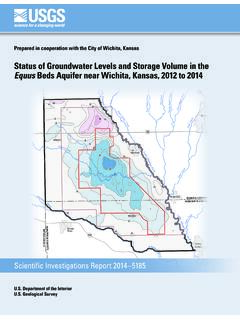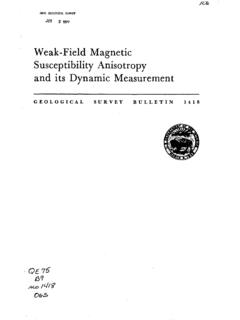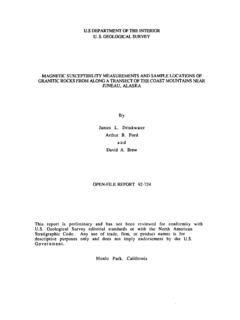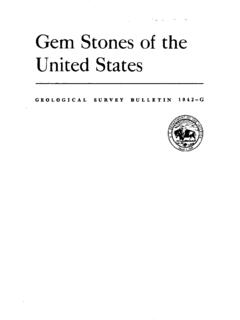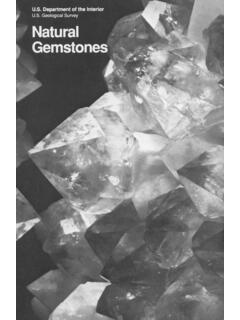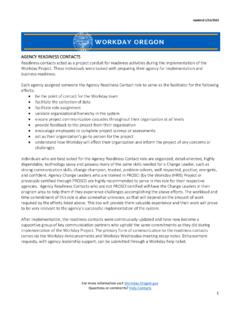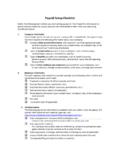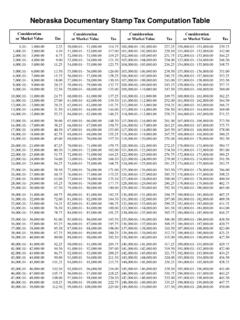Transcription of Lithium - USGS
1 Prepared by Brian W. Jaskula [(703) 648 4908, Lithium (Data in metric tons of Lithium content unless otherwise noted) Domestic Production and Use: The only Lithium production in the United States was from a brine operation in Nevada. Two companies produced a wide range of downstream Lithium compounds in the United States from domestic or imported Lithium carbonate, Lithium chloride, and Lithium hydroxide. Domestic production data were withheld to avoid disclosing company proprietary data. Although Lithium markets vary by location, global end-use markets are estimated as follows: batteries, 71%; ceramics and glass, 14%; lubricating greases, 4%; continuous casting mold flux powders, 2%; polymer production, 2%; air treatment, 1%; and other uses, 6%. Lithium consumption for batteries has increased significantly in recent years because rechargeable Lithium batteries are used extensively in the growing market for portable electronic devices and increasingly are used in electric tools, electric vehicles, and grid storage applications.]
2 Lithium minerals were used directly as ore concentrates in ceramics and glass applications. Salient Statistics United States: 2016 2017 2018 2019 2020e Production W W W W W Imports for consumption 3,140 3,330 3,420 2,620 2,900 Exports 1,520 1,960 1,660 1,680 1,400 Consumption, estimated1 3,000 3,000 3,000 2,000 2,000 Price, annual average, battery-grade Lithium carbonate, dollars per metric ton2 8,650 15,000 17,000 12,700 8,000 Employment, mine and mill, number 70 70 70 70 70 Net import reliance3 as a percentage of estimated consumption >50 >50 >50 >25 >50 Recycling: One domestic company has recycled Lithium metal and Lithium -ion batteries since 1992 at its facility in British Columbia, Canada. In 2015, the company began operating the first recycling facility for Lithium -ion vehicle batteries in Lancaster, OH. Seven other companies located in Canada and the United States have begun recycling, or intend to begin recycling, Lithium metal and Lithium -ion batteries to some degree.
3 Import Sources (2016 19): Argentina, 55%; Chile, 36%; China, 5%; Russia, 2%; and other, 2%. Tariff: Item Number Normal Trade Relations 12 31 20 Other alkali metals ad val. Lithium oxide and hydroxide ad val. Lithium carbonate: pharmaceutical grade ad val. Other ad val. Depletion Allowance: 22% (domestic), 14% (foreign). Government Stockpile:4 Material Inventory as of 9 30 20 FY 2020 FY 2021 Potential acquisitions Potential disposals Potential acquisitions Potential disposals Lithium cobalt oxide (kilograms, gross weight) 750 Lithium nickel cobalt aluminum oxide (kilograms, gross weight) 2,700 Lithium -ion precursors (kilograms, gross weight) Events, Trends, and Issues: Excluding production, worldwide Lithium production in 2020 decreased by 5% to 82,000 tons of Lithium content from 86,000 tons of Lithium content in 2019 in response to Lithium production exceeding consumption and decreasing Lithium prices.
4 Global consumption of Lithium in 2020 was estimated to be 56,000 tons of Lithium content, about the same as that of 2019. During the first half of 2020, the economic impact of the global COVID-19 pandemic was reported to have been a substantial factor in the reduction of customer demand. The second half of 2020 saw Lithium demand increase owing primarily to strong growth in the Lithium -ion battery market. Geological Survey, Mineral Commodity Summaries, January 2021 Lithium Spot Lithium carbonate prices in China decreased from approximately $7,100 per ton at the beginning of the year to about $6,200 per ton in November. For large fixed contracts, the annual average Lithium carbonate price was $8,000 per metric ton in 2020, a 37% decrease from that of 2019. Spot Lithium hydroxide prices in China decreased from approximately $7,800 per ton at the beginning of the year to about $7,000 per ton in November. Spot Lithium metal ( Lithium ) prices in China decreased from approximately $83,000 per ton at the beginning of the year to about $71,000 per ton in November.
5 Five mineral operations in Australia, two brine operations each in Argentina and Chile, and two brine and one mineral operation in China accounted for the majority of world Lithium production. Owing to overproduction and decreased prices, several established Lithium operations postponed capacity expansion plans. Junior mining operations in Australia and Canada ceased production altogether. Lithium supply security has become a top priority for technology companies in the United States and Asia. Strategic alliances and joint ventures among technology companies and exploration companies continued to be established to ensure a reliable, diversified supply of Lithium for battery suppliers and vehicle manufacturers. Brine-based Lithium sources were in various stages of development in Argentina, Bolivia, Chile, China, and the United States; mineral-based Lithium sources were in various stages of development in Australia, Austria, Brazil, Canada, China, Congo (Kinshasa), Czechia, Finland, Germany, Mali, Namibia, Peru, Portugal, Serbia, Spain, and Zimbabwe; and Lithium -clay sources were in various stages of development in Mexico and the United States.
6 World Mine Production and Reserves: Reserves for Argentina, Australia, Canada, Chile, China, the United States, Zimbabwe, and other countries were revised based on new information from Government and industry sources. Mine production Reserves5 2019 2020e United States W W 750,000 Argentina 6,300 6,200 1,900,000 Australia 45,000 40,000 64,700,000 Brazil 2,400 1,900 95,000 Canada 200 530,000 Chile 19,300 18,000 9,200,000 China 10,800 14,000 1,500,000 Portugal 900 900 60,000 Zimbabwe 1,200 1,200 220,000 Other countries7 2,100,000 World total (rounded) 886,000 882,000 21,000,000 World Resources:5 Owing to continuing exploration, identified Lithium resources have increased substantially worldwide and total about 86 million tons. Lithium resources in the United States from continental brines, geothermal brines, hectorite, oilfield brines, and pegmatites are million tons. Lithium resources in other countries have been revised to 78 million tons.
7 Lithium resources are Bolivia, 21 million tons; Argentina, million tons; Chile, million tons; Australia, million tons; China, million tons; Congo (Kinshasa), 3 million tons; Canada, million tons; Germany, million tons; Mexico, million tons; Czechia, million tons; Serbia, million tons; Peru, 880,000 tons; Mali, 700,000 tons; Zimbabwe, 500,000 tons; Brazil, 470,000 tons; Spain, 300,000 tons; Portugal, 270,000 tons; Ghana, 90,000 tons; and Austria, Finland, Kazakhstan, and Namibia, 50,000 tons each. Substitutes: Substitution for Lithium compounds is possible in batteries, ceramics, greases, and manufactured glass. Examples are calcium, magnesium, mercury, and zinc as anode material in primary batteries; calcium and aluminum soaps as substitutes for stearates in greases; and sodic and potassic fluxes in ceramics and glass manufacture. eEstimated. W Withheld to avoid disclosing company proprietary data. Zero. 1 Defined as production + imports exports + adjustments for Government and industry stock changes.
8 Rounded to one significant digit to avoid disclosing company proprietary data. 2 Source: Industrial Minerals, Lithium carbonate, large contracts, delivered continental United States. 3 Defined as imports exports + adjustments for Government and industry stock changes. 4 See Appendix B for definitions. 5 See Appendix C for resource and reserve definitions and information concerning data sources. 6 For Australia, Joint Ore Reserves Committee-compliant reserves were million tons. 7 Other countries with reported reserves include Austria, Congo (Kinshasa), Czechia, Finland, Germany, Mali, and Mexico. 8 Excludes production.
